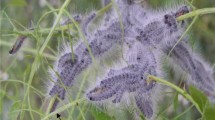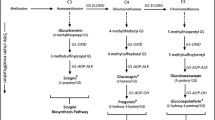Abstract
In a laboratory study 150 sorghum plants were infested with greenbugs,Schizaphis graminum (Rondani), of ages 1, 3, and 5 days in densities of 5, 10, and 20 aphids per plant. Seventy-five of these infested plants were exposed to mated femaleLysiphlebus testaceipes (Cresson), and the number of aphids leaving each plant in a 4-hr period was recorded. Of the 75 plants exposed to parasitoids, an average of 41.0% of the aphids left the plants, compared to 0.9% from the 75 control plants. Twenty-six of the 75 parasitoids used in the experiment were inactive in the presence of aphids, showing no interest in searching for hosts. The number of inactive parasitoids was inversely related to the number of aphids per plant. When only those plants exposed to active parasitoids were considered, an average of 62.8% of the aphids left.
To determine the fate of greenbugs leaving plants on hot, sunny, summer days, a small field test was performed in which greenbugs were knocked from plants onto soil exposed to direct sunlight. Air temperature was ca. 29°C and soil temperatures ranged from 45°C to 54°C. Twenty-four greenbugs were knocked to the soil, and all of them ceased activity within 10 seconds and were apparently dead.
Résumé
Au laboratoire, 150 plantes de sorgho ont été infestées par des pucerons verts,Schizaphis graminum (Rondani) âgés de 1, 3 et 5 jours à raison de 5, 10 et 20 pucerons par plante. 75 de ces plantes infestées ont été présentées à une femelle accouplée deLysiphlebus testaceipes (Cresson) et on a noté le nombre de pucerons vivant sur chaque plante après 4 heures. Pour les 75 plantes exposées aux parasitoides, 41% en moyenne des aphides ont quitté les plantes, au lieu de 0,9% pour les plantes témoins. 26 des 75 parasitoides employés furent inactifs en présence des pucerons, ne manifestant aucune activité de recherche des hôtes. Le nombre de parasitoides inactifs était en raison inverse du nombre de pucerons par plante. Si l'on considère seulement les plantes soumises à des parasitoides actifs, une moyenne ds 62,8% des pucerons ont disparu.
Pour déterminer le sort des pucerons partis des plantes par des journées d'été chaudes et ensoleillées, on a réalisé un petit essai sur le terrain dans lequel on a fait tomber les pucerons sur le sol exposé directement à l'insolation. La température de l'air était d'environ 29°C et celle du sol variait de 45°C à 54°C. 24 pucerons furent projetés sur le sol, tous cessèrent leur activité en 10 secondes et étaient apparemment morts.
Similar content being viewed by others
References
Broadbent, L. &Hollings, M. — 1951. The influence of heat on some aphids. —Ann. Appl. Biol., 38, 577–581.
Eikenbary, R. D. &Rogers, C. E. — 1974. Importance of alternate hosts in establishment of introduced parasites. —Proc. Tall Timbers Conf. & Ecol. Anim. Control by Habitat Manag., 5, 119–133.
Fenton, F. A. &Fisher, E. H. — 1940. The 1939 greenbug outbreak in Oklahoma. —J. Econ. Entomol. 33, 628–639.
Hight, S. C., Eikenbary, R. D., Miller, R. J. &Starks, K. J. — 1972. The greenbug andLysiphlebus testaceipes. —Environ. Entomol, 1, 205–209.
Hunter, S. J. & Glenn, P. A. — 1909. The greenbug and its enemies. —Sci. Bull. Univ. Kans., 9, 221 p.
Nault, L. R., Edwards, L. J. &Styer, W. E. — 1973. Aphid alarm pheromones: secretion and reception. —Environ. Entomol., 2, 101–105.
Ruth, W. E., Caves, D. W. &Eikenbary, R. D. — 1974 Greenbugs less than six hours old as hosts toLysiphlebus testaceipes. —Environ. Entomol., 3, 355–356.
Schlinger, E. I. &Hall, J. C. — 1960. The biology, behavior, and morphology ofPraon palitans Muesebeck, an internal parasite of the spotted alfalfa aphid,Therioaphis maculata (Buckton) [Hymenoptera: Braconidae, Aphidiinae]. —Ann. Antomol. Soc. Am., 53, 144–160.
Sekhar, P. S. — 1957. Mating, oviposition, and discrimination of hosts byAphidius testaceipes (Cresson) andPraon aguti (Smith), primary parasites of aphids. —Ann. Entomol. Soc. Am., 50, 370–375.
Spencer, H. — 1926. Biology of the parasites and hyperparasites of aphids. —Ann. Entomol. Soc. Am., 19, 119–157.
Tamaki, G. J., Halfhill, E. &Hathaway, D. O. — 1970. Dispersal and reduction of colonies of pea aphids byAphidius smithi [Hymenoptera: Aphidiidae]. —Ann. Entomol. Soc. Am., 63, 973–980.
Webster, F. M. & Phillips, W. J. — 1912. The spring grain aphid or “greenbug”. —Bull. USDA Bur. Entom., No. 110, 153 p.
Author information
Authors and Affiliations
Additional information
Journal article of the Agricultural Experiment Station, Oklahoma State University, Stillwater, Oklahoma. This research was conducted in cooperation with the USDA Agric. Res. Serv., Southern Region. Cooperative Agreement No. 12-14-100-10,612 (33).
Rights and permissions
About this article
Cite this article
Ruth, W.E., McNew, R.W., Caves, D.W. et al. Greenbugs [Hom.: Aphididae] forced from host plants byLysiphlebus Testaceipes [Hym.; Braconidae] . Entomophaga 20, 65–71 (1975). https://doi.org/10.1007/BF02373451
Issue Date:
DOI: https://doi.org/10.1007/BF02373451




